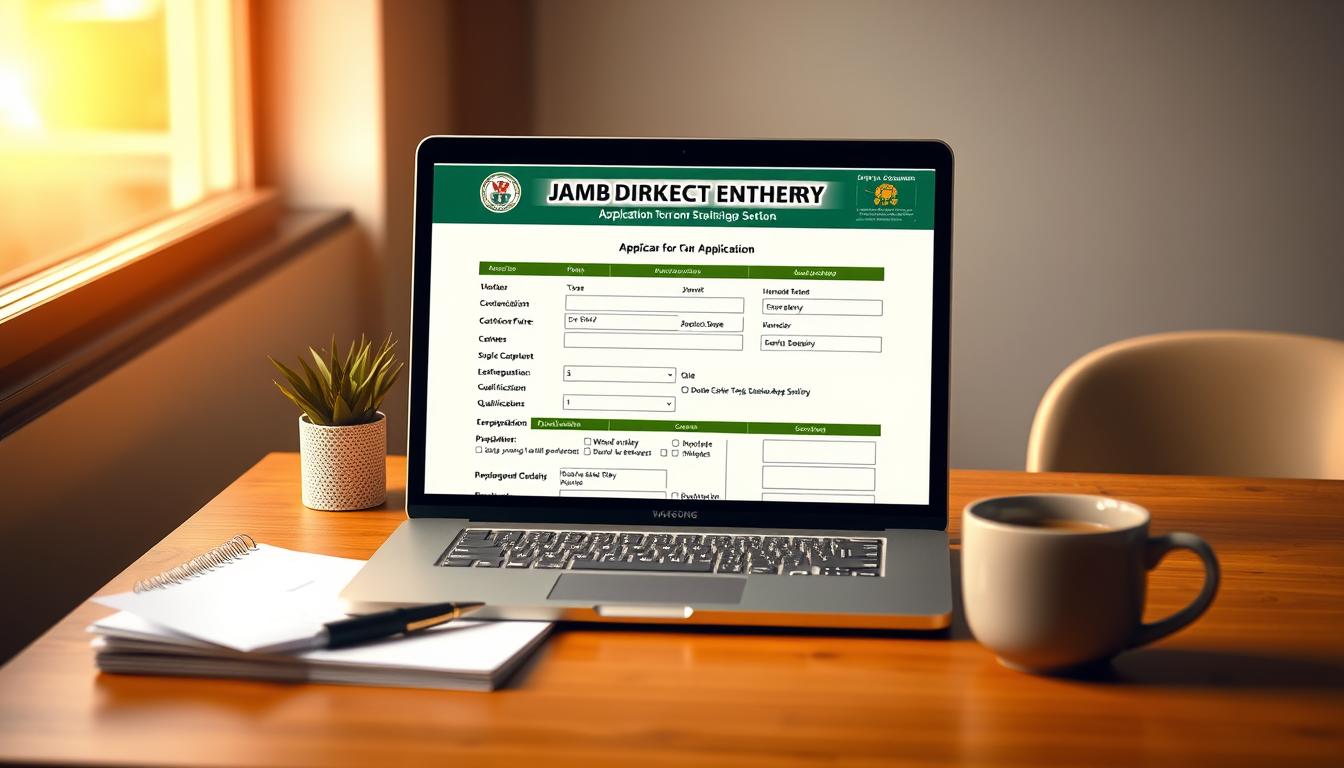Direct Entry Applications in Nigeria 2025: What You Need to Know
The Direct Entry application process is a crucial pathway for prospective students seeking admission into Nigerian universities. As the academic year 2025 approaches, understanding the requirements and procedures for JAMB Direct Entry is essential.
Prospective students must be aware of the necessary documents, eligibility criteria, and deadlines to successfully navigate the Direct Entry application Nigeria 2025 process.
Key Takeaways
- Understanding the JAMB Direct Entry process is crucial for prospective students.
- The Direct Entry application process has specific requirements and deadlines.
- Eligibility criteria must be met to qualify for Direct Entry.
- Necessary documents must be prepared in advance.
- The application process can be complex, but with proper guidance, it can be navigated successfully.
- Staying informed about updates and changes to the Direct Entry process is vital.
Understanding Direct Entry in Nigerian Higher Education
Understanding the nuances of direct entry is crucial for prospective students in Nigeria’s higher education landscape. Direct entry is an admission pathway that allows candidates with qualifications beyond the ordinary level to gain entry into Nigerian universities.
What Is Direct Entry and How It Differs from UTME
Direct entry is distinct from the Unified Tertiary Matriculation Examination (UTME), which is the standard entrance examination for Nigerian universities. While UTME is open to candidates with secondary school qualifications, direct entry is designed for those with higher qualifications, such as Advanced Level certificates, National Diplomas, or Higher National Diplomas.
The key difference lies in the entry requirements and the admission process. UTME candidates must sit for the examination and score a certain threshold set by the Joint Admissions and Matriculation Board (JAMB) and their chosen institutions. In contrast, direct entry candidates are admitted based on their existing qualifications, which are considered to be at a level that allows them to bypass the UTME.
Who Qualifies for Direct Entry in Nigeria
To qualify for direct entry into Nigerian universities, candidates typically need to possess certain academic qualifications. These include:
- Advanced Level certificates (e.g., A-Levels, IJMB)
- National Diploma (ND) or Higher National Diploma (HND) in a relevant field
- First Degree from a recognized university
- Professional qualifications recognized by Nigerian universities
It’s essential for prospective direct entry students to check the specific requirements of their chosen institutions, as these can vary. Additionally, candidates must meet other criteria, such as age and citizenship requirements, which are detailed by JAMB and the respective universities.
Direct Entry Requirements for 2025
As the 2025 academic year approaches, prospective students in Nigeria need to understand the direct entry requirements for a smooth application process. Direct entry into Nigerian universities is a sought-after pathway for individuals with relevant qualifications. To navigate this process successfully, applicants must be aware of the specific requirements that govern direct entry admissions.
Academic Qualifications Needed
To be eligible for direct entry into Nigerian universities, applicants must possess certain academic qualifications. Typically, these include Advanced Level certificates such as A-Levels, IJMB, or Cambridge GCE. The specific subjects and grades required can vary depending on the course and institution. For instance, some programs may require science-related subjects for science-based courses.
Age and Citizenship Requirements
Age and citizenship are also critical factors in determining eligibility for direct entry. Generally, there is no specific age limit for direct entry applicants, but applicants must be Nigerian citizens or meet specific criteria for international students. Citizenship requirements may vary, so it’s essential to check with the relevant institutions.
Institution-Specific Requirements
Different universities and institutions in Nigeria may have unique requirements for direct entry admissions. These can include additional exams, interviews, or specific documentation. For example, some universities might require applicants to undergo a screening process or submit supplementary documents. It’s crucial for applicants to research the specific requirements of their chosen institutions.
How to Apply for Direct Entry in 2025 in Nigeria
The journey to securing a direct entry admission in Nigerian institutions begins with a well-informed application process. As a prospective student, understanding the steps involved in applying for direct entry is crucial for a successful outcome.
Creating a JAMB Profile
The first step in the direct entry application process is creating a profile on the Joint Admissions and Matriculation Board (JAMB) portal. This profile is essential for all subsequent actions, including purchasing the direct entry form and completing your application. To create a JAMB profile, navigate to the JAMB website, provide the required personal details, and follow the prompts to complete your registration.
It’s crucial to ensure that the information provided during profile creation is accurate and matches your identification documents. Any discrepancy can lead to issues during the verification process.
Purchasing the Direct Entry Form
Once your JAMB profile is created, the next step is to purchase the direct entry form. This can be done directly on the JAMB portal using the profile you created. The direct entry form is a critical document that officially commences your application process.
To purchase the form, log in to your JAMB profile, navigate to the direct entry section, and follow the instructions. You will need to make a payment using one of the approved payment methods. Upon successful payment, you will receive a confirmation, and your direct entry form will be made available for completion.
Completing Your Application
After purchasing the direct entry form, you will need to log back into your JAMB profile to complete the application. This involves providing detailed information about your academic qualifications, including your Advanced Level certificates or their equivalents. Ensure that all details are accurate and match your supporting documents.
The application form will also require you to select your preferred institution and course. It’s essential to research and choose institutions that align with your qualifications and interests.
Uploading Required Documents
The final step in the direct entry application process is uploading the required documents. These typically include your academic certificates, transcripts, and identification documents. Ensure that all documents are scanned clearly and meet the specifications provided by JAMB.
To upload your documents, navigate to the relevant section on your JAMB profile, select the documents you wish to upload, and follow the prompts. Confirmation of successful upload is usually provided on the portal.
By carefully following these steps, prospective students can ensure a smooth and successful direct entry application process in Nigeria for 2025.
Step-by-Step Guide to the 2025 Direct Entry Application Process
To successfully apply for Direct Entry in 2025, candidates must follow a series of critical steps. The process is designed to be efficient and straightforward, ensuring that applicants can navigate it with ease.
Research and Preparation
The first step in the Direct Entry application process is thorough research and preparation. Prospective students should start by researching institutions that offer their desired courses and understanding the specific requirements for Direct Entry.
This involves checking the institutions’ websites, contacting their admissions offices, and gathering information about the necessary documents and qualifications.
Registration and Form Purchase
Once prepared, candidates should proceed to register on the JAMB portal and create a profile. This is a crucial step as it enables them to purchase the Direct Entry form.
The registration process involves providing personal details and creating a login credential, which will be used throughout the application process.
Form Completion and Submission
After purchasing the Direct Entry form, applicants should carefully complete the application form, ensuring that all information is accurate and matches their supporting documents.
The form will require details such as academic qualifications, institution choices, and contact information. It’s essential to review the form for errors before submission.
Document Verification
The final step involves uploading and verifying the required documents. This includes academic certificates, transcripts, and identification documents.
Candidates must ensure that all documents are clear, legible, and meet the specified requirements to avoid any issues during the verification process.
Important Dates and Deadlines for 2025 Applications
As the 2025 direct entry application season approaches, it’s crucial to be aware of the key dates and deadlines. The Joint Admissions and Matriculation Board (JAMB) and various institutions in Nigeria have specific timelines that prospective students must adhere to.
Understanding these dates is essential for a successful application process. It helps candidates prepare adequately and avoid last-minute rushes or missed opportunities.
Application Opening and Closing Dates
The application process for direct entry typically begins with the release of the JAMB Direct Entry form. Prospective students should check the JAMB website regularly for updates on when the form will be available.
Once the form is released, candidates have a limited time to complete and submit their applications. The closing date is usually several weeks after the opening date, and it’s crucial to submit applications before this deadline.
Screening and Interview Schedules
After submitting their applications, candidates may be required to participate in screening or interviews conducted by their chosen institutions. These screenings are usually scheduled by the institutions themselves.
The dates for screenings and interviews vary by institution, and candidates should check the specific requirements and schedules for each institution they’re applying to. Being aware of these dates helps candidates prepare and plan accordingly.
In conclusion, being informed about the important dates and deadlines is critical for a smooth direct entry application process. Candidates should stay updated on application periods and institutional screening schedules to maximize their chances of success.
Required Documents for Direct Entry Application
Understanding the required documents is vital for a smooth Direct Entry application. Applicants must ensure they have all necessary documents to avoid delays or rejection of their application.
Academic Certificates and Transcripts
The first set of documents required are academic certificates and transcripts. These include:
- Original certificates and transcripts from previous educational institutions attended.
- Certified true copies of these documents, as required by the institution.
It’s essential to have both the original and certified true copies ready for verification purposes.
Identification Documents
Identification documents are crucial for verifying the applicant’s identity. These typically include:
- A valid National Identity Card or Passport.
- A Birth Certificate or other government-issued ID.
Ensure these documents are valid and not expired, as they are critical for the application process.
Other Supporting Documents
Depending on the institution and the specific program applied for, additional documents may be required. These can include:
- Letters of recommendation from academic or professional referees.
- Proof of relevant work experience, if required by the program.
- Any other documents specified by the institution or JAMB.
It’s crucial to check the specific requirements of the institution and program you’re applying to, to ensure you have all necessary documents.
Direct Entry Application Fees and Payment Methods
Prospective students seeking admission through Direct Entry in Nigeria need to understand the associated application fees. The costs involved in applying for Direct Entry can vary, and being informed is crucial for budgeting and planning.
The Joint Admissions and Matriculation Board (JAMB) is the primary body responsible for regulating Direct Entry admissions in Nigeria. As such, understanding the JAMB application fees is a critical aspect of the application process.
JAMB Application Fees for 2025
For the 2025 academic year, JAMB has set a standard fee for Direct Entry applications. This fee is mandatory for all candidates and covers the cost of processing and managing applications.
The JAMB Direct Entry application fee for 2025 is ₦5,000. This fee is non-refundable and non-transferable, emphasizing the importance of accuracy during the application process.
Institution-Specific Fees
In addition to the JAMB application fee, some institutions may charge their own fees for Direct Entry applications. These fees can vary significantly from one institution to another, depending on their specific requirements and policies.
| Institution Type | Average Additional Fee | Payment Method |
|---|---|---|
| Federal Universities | ₦2,000 – ₦5,000 | Bank Payment/Remita |
| State Universities | ₦1,500 – ₦3,000 | Bank Payment/Remita |
| Private Universities | ₦5,000 – ₦10,000 | Bank Payment/Remita or Online Payment Gateway |
Candidates are advised to check with their chosen institutions for specific fee structures and payment methods to avoid any confusion or additional charges.
Understanding the fees associated with Direct Entry applications is a crucial step in the admission process. By being aware of both JAMB and institution-specific fees, candidates can better prepare financially and avoid last-minute surprises.
Choosing the Right Institutions and Courses
The Direct Entry application process requires not only meeting the eligibility criteria but also choosing the right institution and course that aligns with one’s previous qualifications. This decision is pivotal as it affects one’s academic and professional future. Therefore, it’s essential to approach this decision with thorough research and careful consideration.
Researching University Requirements
Researching the requirements of various universities is the first step in making an informed decision. Different institutions have different criteria for Direct Entry students, including specific O’Level subjects, grades, and sometimes even additional exams or assessments. Prospective students should compile a list of potential universities and their respective requirements to facilitate comparison.
For instance, some federal universities might require higher grades in specific subjects compared to state or private universities. Understanding these nuances is crucial for a successful application.
Course Compatibility with Previous Qualifications
Ensuring that the chosen course is compatible with one’s previous qualifications is vital. This involves checking if the previous academic qualifications align with the course requirements. For example, a student with a diploma in engineering might be eligible for a degree program in a related field, but the specific requirements can vary between institutions.
Understanding Cut-off Marks for 2025
Cut-off marks are another critical factor in the Direct Entry application process. These marks vary by institution and course, and they can change from year to year. It’s advisable to check the latest cut-off marks for the 2025 admission cycle directly from the institutions’ official websites or through the JAMB (Joint Admissions and Matriculation Board) portal.
| Institution | Course | 2024 Cut-off Mark | 2025 Projected Cut-off Mark |
|---|---|---|---|
| University of Lagos | Computer Science | 250 | 255 |
| University of Ibadan | Mechanical Engineering | 240 | 245 |
| Obafemi Awolowo University | Economics | 230 | 235 |
By carefully researching university requirements, ensuring course compatibility, and understanding cut-off marks, prospective students can make informed decisions that enhance their chances of a successful Direct Entry application in 2025.
University-Specific Direct Entry Requirements
Direct entry into Nigerian universities demands a thorough understanding of the unique requirements for federal, state, and private universities. Each category of universities has its own set of requirements that applicants must fulfill to be considered for admission.
Federal Universities Requirements
Federal universities in Nigeria are known for having stringent admission requirements. For direct entry, these universities typically require candidates to have a relevant diploma or a higher qualification.
- Qualification: A minimum of a National Diploma (ND) or its equivalent from a recognized institution.
- Grades: A good grade, often a Lower Credit or above, in the relevant field of study.
- Screening: Some federal universities may require additional screening or assessments.
State Universities Requirements
State universities also have their specific requirements for direct entry admissions. While these can vary, there are some common criteria.
| University | Qualification Required | Minimum Grade |
|---|---|---|
| State University 1 | ND/HND | Lower Credit |
| State University 2 | ND/HND or equivalent | Upper Credit |
Private Universities Requirements
Private universities in Nigeria have diverse requirements for direct entry, often reflecting their unique institutional focuses and standards.
For example, some private universities may place a strong emphasis on the relevance of the candidate’s previous qualification to the proposed course of study, while others may have specific GPA or grade requirements.
Understanding these requirements is crucial for a successful application. Applicants are advised to research their chosen institutions thoroughly.
Direct Entry for Special Categories
For certain applicants, the Direct Entry process into Nigerian universities has unique considerations. The Direct Entry program is designed to be inclusive, accommodating various categories of applicants, including international students, those with professional qualifications, and candidates with disabilities.
International Students
International students seeking to apply through Direct Entry must meet specific requirements. These include possessing qualifications equivalent to the Nigerian Advanced Level or having a recognized diploma. Universities may have additional requirements, such as English proficiency tests for non-native English speakers.
It’s crucial for international students to research the specific requirements of the universities they’re applying to, as these can vary significantly.
Candidates with Professional Qualifications
Candidates with professional qualifications can also apply through Direct Entry. These qualifications must be recognized by the relevant Nigerian professional bodies. Examples include certifications from ACCA, ICAN, or other accredited professional institutions.
The application process for such candidates involves submitting their professional qualifications along with their academic credentials for assessment.
Candidates with Disabilities
Nigerian universities are committed to providing inclusive education. Candidates with disabilities are encouraged to apply through Direct Entry. Universities are required to provide reasonable accommodations to ensure equal access to education.
Applicants with disabilities should contact the universities they’re applying to directly to discuss their specific needs and the accommodations available.
After Submitting Your Application
The next crucial phase after submitting your Direct Entry application involves tracking your application status and preparing for potential screenings or interviews.
Tracking Your Application Status
After submitting your application, it’s crucial to keep track of its status. Most institutions provide an online portal where you can check the progress of your application using your registration or application number.
Regularly checking your application status can help you stay updated on any additional requirements or changes in the admission process.
| Institution | Application Tracking Method | Contact Information |
|---|---|---|
| University of Lagos | Online Portal | admissions@unilag.edu.ng |
| University of Ibadan | Email Notification | registrar@ui.edu.ng |
| Obafemi Awolowo University | Online Portal & SMS | info@oauife.edu.ng |
Preparing for Screening and Interviews
Some institutions require candidates to undergo a screening or interview as part of the Direct Entry admission process. Preparation is key to making a good impression.
Research the institution’s typical screening or interview questions and practice your responses to common queries related to your academic background and chosen course.
What to Do If Your Application Is Rejected
If your application is rejected, don’t be discouraged. You can consider appealing the decision if you believe there was an error in the processing of your application.
Alternatively, you may choose to apply to a different institution or program that aligns with your qualifications and interests.
Post-Admission Procedures
Congratulations on your admission offer; now it’s time to navigate the post-admission process. After successfully applying for Direct Entry and receiving an admission offer, several steps remain to secure your place at your chosen institution.
Accepting Your Admission Offer
The first step is to formally accept the admission offer. This typically involves logging into the institution’s online portal and following the prompts to confirm your acceptance. It’s essential to meet the deadline for accepting the offer to avoid any complications.
Accepting your admission offer is a commitment to join the institution, and it’s crucial to understand that this step is usually accompanied by a fee. Ensure you are aware of the payment methods and deadlines for this fee.
Registration and Documentation
After accepting your admission offer, the next step involves registration and completing the necessary documentation. This process includes submitting various documents such as academic transcripts, identification proof, and medical certificates. Ensure all documents are accurate and complete to avoid any delays.
The registration process may also involve filling out online forms, attending in-person registration sessions, or a combination of both. It’s advisable to closely follow the institution’s guidelines for a smooth registration process.
Orientation and Matriculation
Orientation is a critical component of the post-admission process, designed to familiarize you with the institution’s environment, policies, and culture. It’s an opportunity to meet with faculty and peers, understand the institution’s expectations, and get acquainted with the facilities.
Following orientation, the matriculation ceremony is a formal event where you are officially welcomed as a member of the institution. It’s a significant event that marks the beginning of your academic journey. Ensure you are prepared for both events by following the instructions provided by the institution.
Common Mistakes to Avoid in Direct Entry Applications
Navigating the Direct Entry application process can be challenging, but being aware of common pitfalls can significantly enhance your chances of success. The Direct Entry application process requires careful attention to detail to ensure that applicants avoid mistakes that could jeopardize their admission prospects.
Application Form Errors
One of the most critical aspects of the Direct Entry application is the accurate completion of the application form. Errors in the application form can lead to delays or even rejection of the application. Common mistakes include providing incorrect personal details, misrepresenting academic qualifications, and failing to fill out all required fields.
To avoid these errors, it is essential to double-check all information before submitting the application. Ensuring that all details are accurate and consistent with the supporting documents is crucial.
Document Submission Issues
The submission of required documents is a critical component of the Direct Entry application process. Incomplete or incorrect documentation can lead to application rejection. Common issues include missing certificates, transcripts that do not meet the required standards, and failure to provide identification documents.
To mitigate these risks, applicants should carefully review the document requirements for their chosen institution and ensure that all documents are properly authenticated and submitted within the specified timeframe.
“The quality of the documents submitted can significantly impact the outcome of the application. Ensuring that all documents are accurate, complete, and properly verified is essential.”
Deadline Misses and How to Prevent Them
Missing the application deadline is a critical mistake that can result in an applicant being unable to apply for that academic session. Effective time management is key to avoiding this pitfall. Applicants should create a timeline that includes all necessary steps, from preparing documents to submitting the application.
To prevent deadline misses, it is advisable to start the application process early and set reminders for critical milestones. Understanding the application timeline and planning accordingly can help ensure that the application is submitted on time.
Tips for a Successful Direct Entry Application
To navigate the complexities of Direct Entry applications in Nigeria, it’s essential to understand the key strategies that can make your application stand out. A well-crafted application is the result of thorough preparation, professional guidance, and diligent follow-up.
Preparing Well in Advance
Early preparation is crucial for a successful Direct Entry application. This involves researching the requirements of your preferred institutions and ensuring that you meet the necessary academic and other qualifications. By starting early, you can avoid last-minute rushes and errors.
It’s also beneficial to create a checklist of required documents and to begin gathering them well before the application deadline. This proactive approach helps in avoiding delays and ensures that your application is complete.
Seeking Professional Guidance
Professional guidance can significantly enhance the quality of your application. Consulting with educational advisors or experts can provide valuable insights into what admissions committees look for in an application. They can also help in tailoring your application to meet specific institutional requirements.
Moreover, professionals can offer tips on how to present your qualifications and experiences effectively, making your application more compelling.
Following Up on Your Application
After submitting your application, it’s important to follow up on its status. This demonstrates your interest in the program and can sometimes expedite the processing of your application. Utilize the tracking systems provided by the institutions or the JAMB portal to monitor the progress of your application.
If there are any issues or additional information is required, be prompt in responding to such requests. This helps in keeping your application on track and avoids unnecessary delays.
Conclusion
Prospective students seeking to gain admission into Nigerian higher education institutions through direct entry in 2025 must carefully navigate the application process. By understanding the requirements, choosing the right institutions and courses, and avoiding common mistakes, applicants can increase their chances of success.
The key to a successful direct entry application lies in thorough preparation, including researching institution-specific requirements, gathering necessary documents, and submitting a well-completed application form. It is also crucial to track application status and prepare for screening and interviews.
By following the guidelines outlined in this article, prospective students can confidently pursue their academic goals through direct entry. A well-planned and executed direct entry application is essential for a smooth transition into Nigerian higher education institutions.
















Post Comment